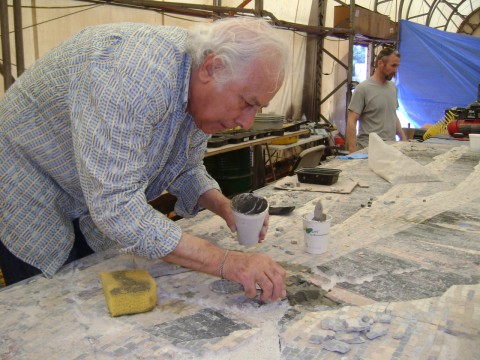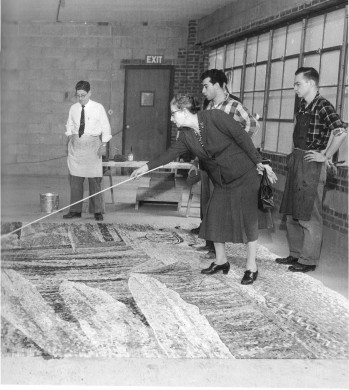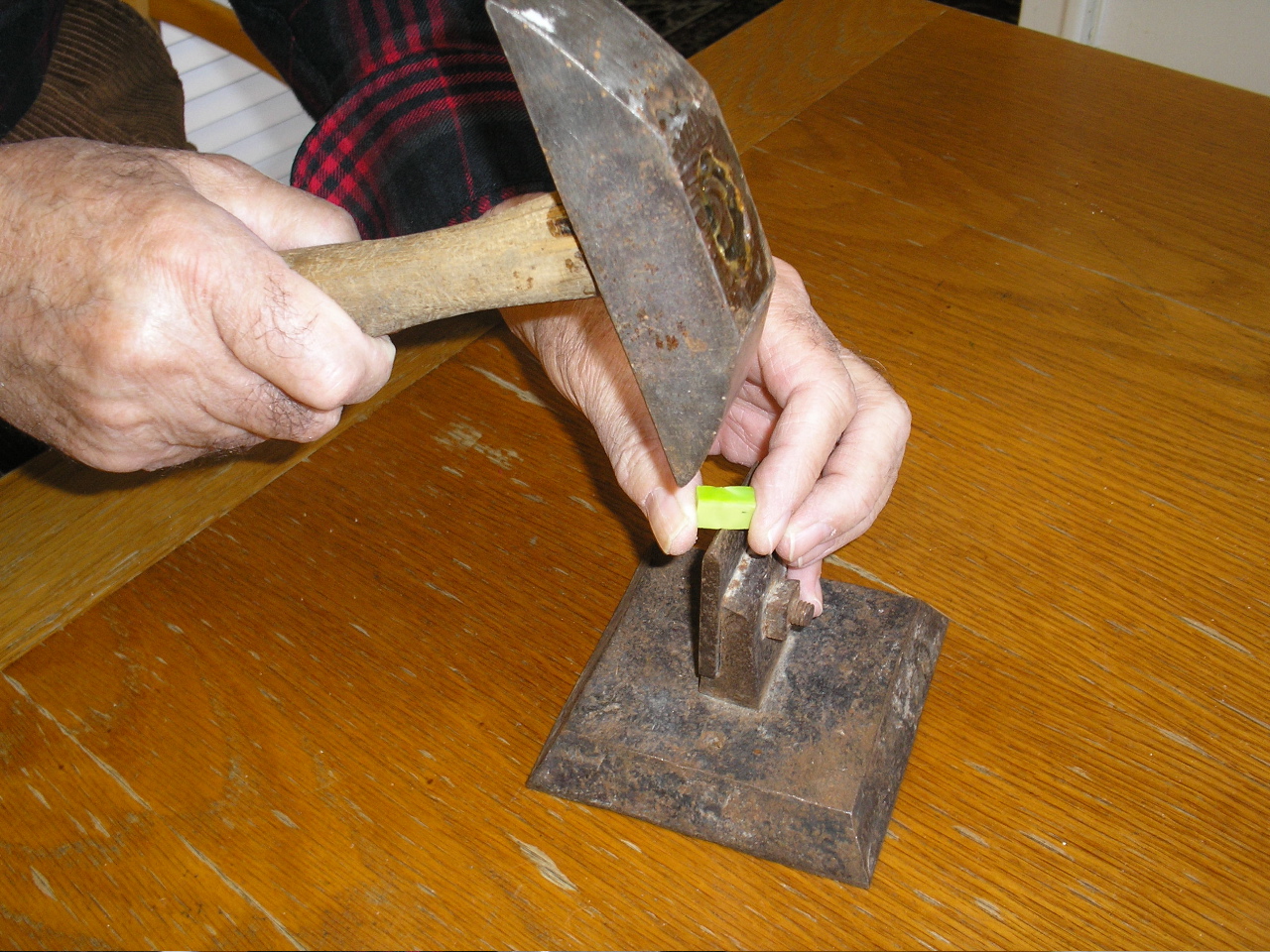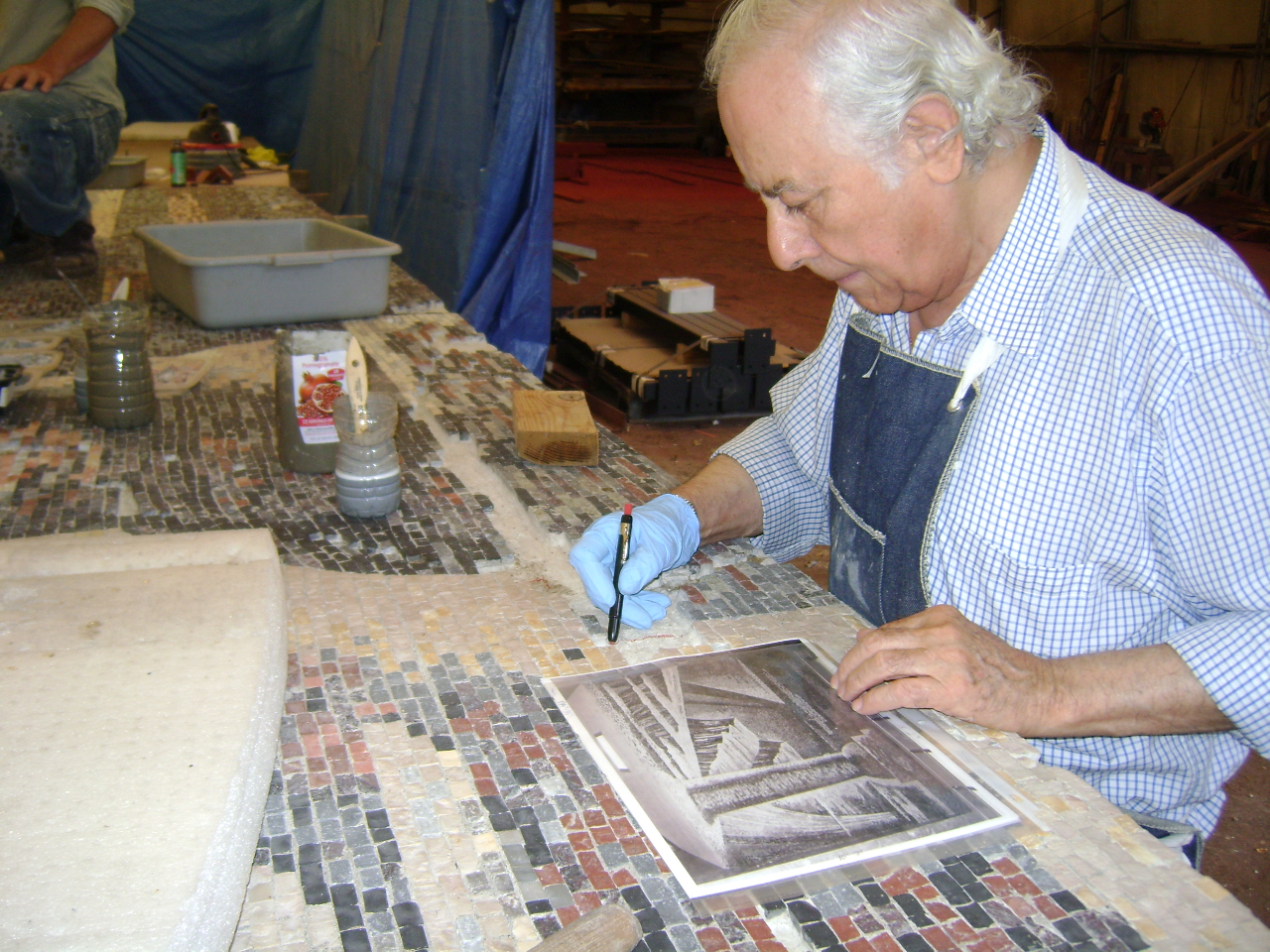
On November 9th a small group of classicists, artists, and visiting scholars gathered outside Harvard’s Center for Hellenic Studies in Washington, D.C. to mark the arrival of two mosaic panels designed by renowned artist Hildreth Meière. The panels were part of a large-scale, triptych mural with the center panel depicting Hercules’ passage through the Straight of Gibraltar, and the two side panels featuring the Pillars of Hercules.
Large mosaics such as these are often a collaborative endeavor, and Anthony Schiavo, who stood among the group that day, had worked on these panels twice. As a young man, he directed the team that fabricated the mosaic. Over 50 years later an unexpected sequence of events brought the mosaics back into his life. Schiavo says the story of how these masterpieces were created, lost, and restored is “a mosaic of a mosaic”, with each individual taking their own place in the progression of the story. The movement or flow created by the arrangement of tesserae in a mosaic is called the andamento, from the Italian verb meaning ‘to move’. This key concept guides the artist during composition, and also when dividing or joining individual sections of the work. For Schiavo, the andamento dei fatti or ‘turn of fate’ leading to this moment began in his hometown, long ago before the first tile was set in place.
The Artist
Anthony David Schiavo was born in 1936 in Monreale, Sicily, a town famous for its 11th century cathedral featuring breathtaking Byzantine mosaics of glass and stone. Fascinated with the images, Anthony began studying and creating mosaics as a young child, and entered a formal program at the Mosaic Institute of Santa Maria Nuova at age 13. He graduated five years later in 1954, but jobs were scarce in Sicily at that time. Since his father was American, the family sought new opportunities across the Atlantic.
The Schiavo family initially settled with relatives in Brooklyn, NY. The mother took a job as a seamstress in the garment district, and Anthony found a job there as well. “I spent three days sewing on buttons, but I knew that wasn’t for me.” He briefly took a position as a draftsman at a marble company in Manhattan. While on a job assignment in Long Island, Anthony noticed a sign for a mosaic company. Founded in 1899 and based on Long Island, V. Foscato Inc. specialized in mosaics and terrazzo work and was a prominent and influential business in New York during the first half of the twentieth century. In fact, skilled artisans—especially Italian mosaic and terrazzo workers–were highly sought after during this period. So when he saw the sign, Anthony entered, found an employee who spoke Italian, and inquired about work. Vincent Foscato Sr., the son of the founder, offered him a position, but due to union regulations, Anthony would have to work as an apprentice for two years–even though he had graduated from a distinguished formal program in Italy. Anthony agreed.
Those first years presented many challenges. For one thing, he was still learning English and often had to communicate through a translator. There was animosity from the other craftsmen who were from Friuli, a region above Venice which was also famous for mosaics. Working conditions were difficult. In Italy, the mosaic fabricators generally sat at stools, but in the U.S. he was only given a stick with a piece of wood on top. One day Anthony turned to his translator and said, “Tell them I’d like to have a stool.” The boss sarcastically asked if he wanted a pillow on top, to which Anthony replied, “Yes”. He was willing to push limits, but he did good work. The next day, he had a stool. In fact, Anthony’s talent quickly earned him the most ornate and interesting jobs.
Meière and the Rock

In 1959, just three years after completing his apprenticeship, Schiavo began working with Hildreth Meière, one of the great American artists of the twentieth century. Born in 1892, Meière was the most sought after and prolific Art Deco muralist during the 1930s and ‘40s, and a highly influential figure in American Liturgical Art. Although conservative in many respects, Meière was also willing to push limits; perhaps it was this balance that allowed her to become one of the few prominent and respected women artist of her time. In 1956 she was the first woman to be honored with the Fine Arts Medal of the American Institute of Architects. The citation for the award praised not only her artistic skill, but also her ability to collaborate with craftsmen and architects in a way that made her art seemingly indivisible from its surroundings. Unfortunately that would not be the fate for the work that Meière and Schiavo created in 1960.
Schiavo still remembers meeting Meière: “She was very elegant, eloquent, and a great artist.” She was also the first woman artist he met with in America.
A year later Meière was beginning discussions with Foscato about a mural she was designing for Prudential Insurance. The well-known company logo featured the Rock of Gibraltar and the tag line “The Prudential has the Strength of Gibraltar.” Meière had found herself moved by the strength of that landmark when she passed through the Straight decades before. So for the Prudential mural she depicted Hercules sailing through the Straight and past the Rock. In Greek mythology the Pillars indicated the limit of the known world. For mere humans, that spot would mark the limit of their journey, the point where they turn back. Thus Hercules’ journey came to represent a heroic and unending quest for knowledge with the pillars as the gateway to the unknown.

Meière was a master of using such symbols and narratives to convey the cultural significance of a location or organization to the public. The Prudential mosaic draws on a traditional myth about Hercules, but the hero seems remarkably small and mortal surrounded by Meière’s huge, steadfast rock and the two formidable pillars rising up toward the sky. The effect conveys the rock-steady durability and strength of the insurance company in opposition to the heroic but inevitably mortal humans who pass through on their journey while buffeted by fate.
The message fit the company for which it was commissioned, but also reflected something about Meière’s position in life. After having executed over 100 commissioned works, Meière could claim great success. On May 2, 1961 Meière died. The Pillars of Hercules would be her final corporate work.
The Mosaic
In 1960 there was still work to be done. When Meière first came to the studio to discuss the mural Schiavo assured her he only needed a small 20”x30” painting as guidance. That would have saved Meière time and effort, but she enjoyed working on a large scale work and chose to create a full-size gouache painting called a “cartoon”. Schiavo’s first task was to select the proper stones that would achieve the colors the artist wanted. Then he could begin the careful work of translating the cartoon into a mosaic.
Many mosaics are created using the “direct method” in which each tile is fixed directly in place, right side up—that is, the artisan installs the mosaic as it is fabricated. The Prudential mosaic was going to be fabricated at one location and installed at another, requiring an “indirect” or “reverse method”. When using this technique, the tiles are fixed to a temporary “backing” with the front side down. To begin the process Anthony’s team created a full-scale sketch of the design reversed from left to right. The sketch was cut into sections of about two square feet following the shape and flow of the design. Working one section at a time, the craftsmen fixed the front of the tesserae to the paper sketch with a temporary adhesive. With this technique the paper sketch becomes a temporary “backing” for the front of the work, while the back is left exposed for installation.

For each panel in the Prudential mosaic, Anthony and his team meticulously placed over 46,000 individual tiles cut from at least twelve types of marble. Meière was pleased with their work and requested just one revision. She felt the colors in the sunburst over the mountain were too bright. So Schiavo removed the section and then replaced the sunburst with more subdued hues. After four and a half months of work, all three panels were finally complete. Meière and Schiavo congratulated each other, and the panels were carefully sent off for installation in the lobby of Prudential Plaza.
Prompted by Meière, Anthony joined the National Society of Mural Painters and he began designing his own mosaics. After starting his own business in 1965, he became involved with many notable projects, including the installation of the Byzantine style mosaics on the vault of the Santa Sophia Greek Orthodox Cathedral in Washington, D.C. (just minutes away from the Center), and the restoration of ancient Roman mosaics held for Princeton and Harvard Universities.
The Appearance and Return of a Masterpiece
Fifty-three years after his original work on the mosaic was completed, Anthony watched as the crate containing one of those panels was carefully maneuvered into place and then opened, revealing a pillar rising up confidently against a landscape of stone. The pillar now appears to hold up a section of the inner courtyard roof.
Hildreth “Hilly” Meière Dunn, granddaughter and namesake of the late artist, celebrated along side Anthony. As the Vice President of the International Hildreth Meière Association, Hilly is a guardian of her grandmother’s legacy, so she was particularly excited to see these panels achieve a safe homecoming at the Center.
After being installed at the Prudential Headquarters in Newark in 1960, the mural remained in place until 1999 when the panels were removed during renovation and placed in storage. Then, somehow, awareness of the panels was lost. They lingered in obscurity for a decade. During this time her work was still in public view at prominent and cherished landmarks around the country–locations such as the Washington National Cathedral and Radio City Music Hall in New York City. Then in 2009 the Prudential panels were brought back to public awareness.
Among those who facilitated this return is Catherine Coleman Brawer, an author and scholar who first learned about Meière because her apartment was once Meière’s studio. Brawer became intrigued with Meière and over time has become an expert in her work. In 2009 she organized and curated the first major retrospective of Meière’s murals at St. Bonaventure University’s Regina A. Quick Center for the Arts. She also authored a catalogue in connection with the exhibition titled Walls Speak: the Narrative Art of Hildreth Meière.

By coincidence the archivist at Prudential Insurance happened to see the exhibit catalogue and realized that they still had the missing panels. The company contacted Hilly to let her know the good news. Unfortunately, there was also some bad news. The panels had been damaged during removal and storage, one quite extensively. The mural would need expensive, expert restoration before it could be placed back on view for the public.
Right around this time Anthony also came across Brawer’s catalogue, and opened it to find a picture of himself with Meière. He then got in contact with Catherine and Joseph LoSchiavo, Associate Vice-President, St. Bonaventure University and Executive Director at the Quick Center. They, in turn, put him in touch with Hilly to talk about the possibility of restoring the mural. They all agreed—they needed to save the mural somehow. This was an amazing opportunity to have the original mosaic artist undertake the restoration, but how would they fund the project, and where would the panels find a home?

In the end Prudential donated the panels and the Ruth Dayton Foundation provided a grant to cover the restoration. The first section to be restored was the center panel featuring Hercules and the Rock of Gibraltar. Anthony knew he needed help. “At 77 I can’t jump like a monkey anymore!” So he arranged to collaborate on the restoration with a talented and experienced mosaic artist named Stephen Miotto. Anthony had followed Miotto’s work for 34 years—since Miotto was an apprentice at 16. Together they were able to restore the panel to its original condition. Prudential then donated the work to the Newark Museum, but the two side panels needed a home.
In 2011 Thomas Luebke, Secretary of the U.S. Commission of Fine Arts, spoke with Catherine Brawer following a lecture she gave about Meière. She told Luebke about the two panels and her hope of seeing them installed in a place where the meaning of the panels might have great value. Luebke immediately thought of the Center. Founded in 1965 with the mission of establishing “an educational center in the field of Hellenic Studies designed to rediscover the humanism of the Hellenic Greeks”, the CHS welcomes scholars from around the globe who come to work at one of the world’s premier research libraries. When Director Gregory Nagy and Administrative Director Zoie Lafis were contacted about the mosaics, they were excited about the possibility of having the Center acquire these important works. Once funding was secured to restore both panels, Schiavo and Miotto began repairing the damage. These works would soon have a fitting and permanent home.
Homecoming
For the ancient Greeks, a homecoming, or nostos, could be associated with an awakening of consciousness and even a “return to light and life”. Nagy sees echoes of these themes in the imagery of the mosaics and in their new location near the entrance to the research library. Nagy believes the symbolism of the Pillars and their return from obscurity to public view perfectly express the mission of the Center and the unending quest for knowledge.
Schiavo, Nagy, Brawer, Hilly, and many others who contributed to this mosaic of homecoming will return to the Center in the spring for a formal celebration. Until then, Anthony Schiavo will continue this work. He regrets that mosaics are often not treated as valuable works of art, but encouraged by this experience, he hopes to raise public awareness so that more masterpieces can be found and restored.
